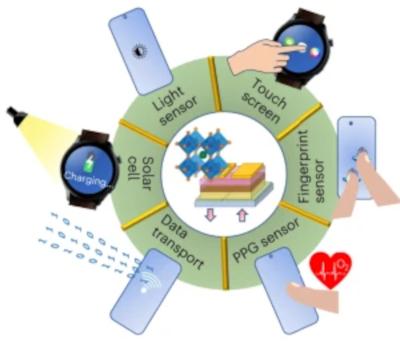What are perovskites?
Perovskite is a calcium titanium oxide mineral, with the chemical formula CaTiO3, discovered in the Ural Mountains of Russia by Gustav Rose in 1839 and named after Russian mineralogist Lev Perovski (1792–1856).
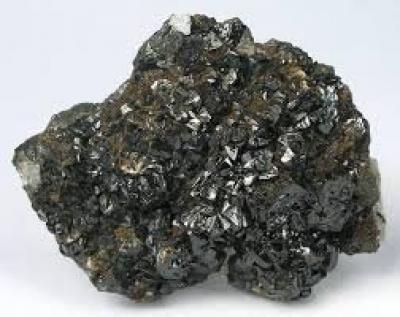
Perovskites are a class of materials with a similar structure that are easily synthesized and relatively low-cost. Perovskites are considered the future of solar cells and are also predicted to play a significant role in next-gen electric vehicle batteries, displays, sensors, lasers and much more.
Perovskites can have an impressive collection of interesting properties including “colossal magnetoresistance” - their electrical resistance changes when they are put in a magnetic field (which can be useful for microelectronics). Some Perovskites are superconductors, which means they can conduct electricity with no resistance at all. Perovskite materials exhibit many other interesting and intriguing properties. Ferroelectricity, charge ordering, spin dependent transport, high thermopower and the interplay of structural, magnetic and transport properties are commonly observed features in this family. Perovskites therefore hold exciting opportunities for physicists, chemists and material scientists.
What are LEDs?
A light-emitting diode (LED) is an electronic component that is essentially a two-lead semiconductor light source. It is a p–n junction diode that emits light upon activation by a voltage applied to the leads, which makes electrons recombine with electron holes within the device, releasing energy in the form of photons. This effect is called electroluminescence, and the color of the light is determined by the energy band gap of the chosen semiconductor.
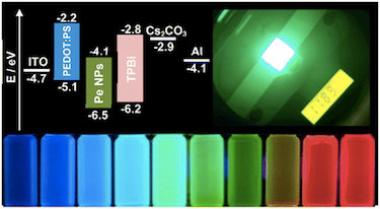
LEDs’ advantages over incandescent light sources include lower energy consumption, longer lifetime, improved physical robustness, smaller size, and faster switching. Light-emitting diodes have become ubiquitous and are found in diverse applications in the aerospace and automotive industries, as well as in advertising, traffic signals, camera flashes and much more.
LEDs meant for general room lighting currently remain more expensive than fluorescent or incandescent sources of similar output, but are significantly more energy efficient.
What can perovskites do for LEDs?
Current high-quality LEDs are based on direct bandgap semiconductors, but making these devices is no easy task because they need to be processed at high temperatures and in vacuum, which makes them rather expensive to produce in large quantities. Perovskites that are direct-bandgap semiconductors could be real alternatives to other types of direct-bandgap materials for applications like color displays, since they are cheap and easy to make and can be easily tuned to emit light of a variety of colors.
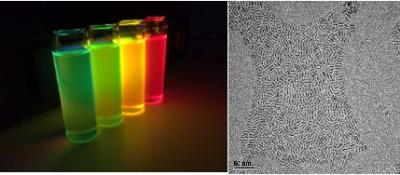
Researchers have found that organometal halide-based perovskites (a combination of lead, organics and halogens that arrange into perovskite crystal structure in the solid state) could be very suitable for making optoelectronics devices, since they can be processed in solution and do not need to be heated to high temperatures. This means that large-area films of these materials can be deposited onto a wide range of flexible or rigid substrates. The perovskites also have an optical bandgap that can be tuned in the visible to infrared regions, which makes them very promising for a range of optoelectronics applications. These materials also emit light very strongly, which makes them very suitable for making LEDs. The light emitted by the perovskites can be easily tuned, which could make them ideal for color displays and lighting, and in optical communication applications.
However, a major obstacle that perovskites will have to overcome in order to be used in LED-type devices is that electrons and holes only weakly bind in perovskite thin films. This means that excitons (electron-hole pairs) spontaneously dissociate into free carriers in the bulk recombination layer, leading to low photoluminescence quantum efficiency (PLQE), high leakage current and low luminous efficiency. This obviously impairs perovskites’ ability to create high-performance LEDs, and for perovskite materials to make a comparable impact in light emission, it is necessary to overcome their slow radiative recombination kinetics. Simply put, researchers will have to find ways of effectively confining electrons and holes in the perovskite so that they can “recombine” to emit light. Major progress is already being made in this field, and it seems that perovskites will indeed open the door to a low-cost, color-tunable approach to LED development.
Recent work in the field of perovskite-based LEDs
In July 2016, researchers at Nanyang Technological University in Singapore have fabricated high-performance green light-emitting diodes based on colloidal organometal perovskite nanoparticles. The devices have a maximum luminous efficiency of 11.49 cd/A, a power efficiency of 7.84 lm/W and an external quantum efficiency of 3.8%. This value is said to be about 3.5 times higher than that of the best colloidal perovskite quantum-dot-based LEDs previously made.
In March 2016, researchers at the University of Toronto in Canada and ShangaiTech University in China have succeeded in using colloidal quantum dots in a high-mobility perovskite matrix to make a near-infrared (NIR) light-emitting diode (LED) with a record electroluminescence power conversion efficiency of nearly 5% for this type of device. The NIR LED could find use in applications such as night vision devices, biomedical imaging, optical communications and computing.
In February 2016, researchers from the Universitat Jaume I and the Universitat de València have studied the interaction of two materials, halide perovskite and quantum dots, revealing significant potential for the development of advanced LEDs and more efficient solar cells. The researchers quantified the "exciplex state" resulting from the coupling of halide perovskites and colloidal quantum dots, both known separately for their optoelectronic properties, but when combined, these materials yield longer wavelengths than can be achieved by either material alone, plus easy tuning properties that together have the potential to introduce important changes in LED and solar technologies.
In December 2015, researchers at Pohang University in Korea are reportedly the first to develop a perovskite light emitting diode (PeLED) that could replace organic LED (OLED) and quantum dot LED (QDLED).
Organic/inorganic hybrid perovskite have much higher color-purity at a lower cost compared to organic emitters and inorganic QD emitters. However, LEDs based on perovskite had previously shown a limited luminous efficiency, mainly due to significant exciton (a complex of an electron and hole that can allow light emission when it is radiatively recombined) dissociation in perovskite layers. The research team overcame the efficiency limitations of PeLED and boosted its efficiency to a level similar to that of phosphorescent OLEDs. This increase was attributed to fine stoichiometric tuning that prevents exciton dissociation, and to nanograin engineering that reduces perovskite grain size, and concomitantly decreases exciton diffusion length. PeLED might be a game changer in the display and solid-state lighting industries, with significantly improved efficiency as well as advantages like excellent color gamut and low material cost.
In November 2015, Florida State researchers have developed a cheaper, more efficient LED, or light-emitting diode, using perovskites. The researchers spent months using synthetic chemistry to fine-tune the materials in the lab, creating a perovskite material capable of emitting a staggering 10,000 candelas per square meter when powered by 12 volts. The scientists say that such exceptional brightness owes, to a large extent, to the inherent high luminescent efficiency of this surface-treated, highly crystalline nanomaterial.
The latest perovskite LED news:
Perovskites’ bright future in the MicroLED industry
Micro-LED (also known as mLED or µLED) is a display technology based on miniature LED devices that are used to directly create color pixels. Micro-LED displays are highly promising and have the potential to create efficient and great looking flexible displays, which could challenge even the most impressive high-end OLED displays. Micro LEDs are attracting significant attention as next-generation displays owing to their desirable characteristics such as low power consumption, high contrast ratio, high brightness, fast response speed, and long life span.
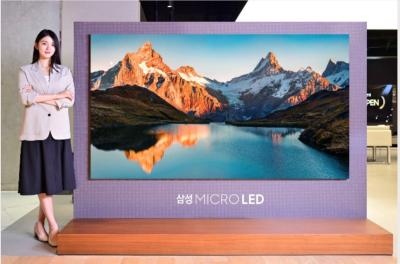
Perovskite materials can benefit the MicroLED industry in two ways: as materials for color conversion (using perovskite-based QDs) and in perovskite-based LED emitters. Much R&D work is taking place on both these fronts, and interest seems to be growing.
Researchers design multifunctional display based on photo-responsive perovskite light-emitting diodes
Researchers at Linköping University, Nanjing University and NanjingTech have developed a multifunctional display that uses photo-responsive metal halide perovskite LEDs as pixels. The perovskite LED display can be simultaneously used as a touch screen, ambient light sensor and image sensor (including for fingerprint drawing) without integrating any additional sensors. The light-to-electricity conversion efficiency of the pixels also allow the display to act as a photovoltaic device that can charge the equipment.
Illustration of functions realized by the multifunctional display. Image from Nature Electronics
This is a step forward compared to current display screens, which are typically only used for information display, but can have a range of different sensors integrated into them for functions such as touch control, ambient light sensing and fingerprint sensing. According to the team, photo-responsive light-emitting diodes (LEDs), which can display information and respond to light excitation, could be used to develop future ultra-thin and large screen-to-body ratio screens. However, photo-response is difficult to achieve with conventional display technologies.
Researchers develop "all-in-one" organic ligand for emitting perovskite nanocrystals
Perovskite nanocrystals (PNCs) have considerable potential as next-generation display materials thanks to their excellent photoluminescence quantum yield (PLQY), wide color gamut, and narrow emission bandwidth. However, due to their weak stability against solvents, their patterning remains a challenge. In a recent study, researchers at Ajou University, Hanyang University, Sungkyunkwan University, Macquarie University and Kongju National University developed functional organic ligands (AzL1-Th and AzL2-Th) for the fine pixelation of perovskite nanocrystal (PNC) displays.
Functional ligands containing photocurable azide moieties exhibit good charge transport properties and fast and efficient photocrosslinking performance, while maintaining a high PLQY. The team successfully demonstrated the crosslinked PNC light emitting diodes using AzL1-Th. The results suggest the high potential of photocurable ligands for the micro-patterning of PNC films without film damages.
Researchers develop method for enhancing the performance of blue perovskite LEDs
Researchers at the University of Cambridge, University of Science and Technology of China, Shanghai Jiao Tong University, Soochow University, OIST, Hong Kong University of Science and Technology, Victoria University of Wellington and Kyushu University have demonstrated efficient blue perovskite LEDs based on a mixed two-dimensional–three-dimensional perovskite and a multifunctional ionic additive that enables control over the reduced-dimensional phases, non-radiative recombination channels and spectral stability.
The team reported a series of devices that emit efficient electroluminescence from mixed bromide/chloride quasi-three-dimensional regions, with external quantum efficiencies of up to 21.4% (at a luminance of 22 cd m–2 and emission peak at 483 nm), 13.2% (at a luminance of 2.0 cd m–2 and emission peak at 474 nm) and 7.3% (at a luminance of 6 cd m–2 and emission peak at 464 nm). The devices showed a nearly 30-fold increase in operational stability compared with control LEDs, with a half-lifetime of 129 min at an initial luminance of 100 cd m–2.
Perovskite-Info launches a new edition of its Perovskite for Displays Market Report
Perovskite-Info is proud to announce an update to our Perovskite for the Display Industry Market Report. This market report, brought to you by the world's leading perovskite and OLED industry experts, is a comprehensive guide to next-generation perovskite-based solutions for the display industry that enable efficient, low cost and high-quality display devices. The report is now updated to February 2024, with all the latest commercial and research activity. This was a major version, with over 15 updates, new companies and new technologies covered.
Reading this report, you'll learn all about:
- Perovskite materials and their properties
- Perovskite applications in the display industry
- Perovskite QDs for color conversion
- Prominent perovskite display related research activities
The report also provides a list of perovskite display companies, datasheets and brochures of pQD film solutions, an introduction to perovskite materials and processes, an introduction to emerging display technologies and more.
Researchers develop new sieving technique for better perovskite LEDs
Researchers at the Chinese Academy of Sciences (CAS), University of Nottingham Ningbo China and University of Science and Technology of China have developed a novel solvent sieve method that significantly enhances the performance and operational stability of perovskite light-emitting diodes (PeLEDs).
Perovskites' practical application in PeLEDs has thus been constrained by their low operational stability. The recent research, centered on a comprehensive analysis of perovskite nanostructures, identified the presence of defective low n-phase perovskites as a primary factor undermining device stability. These defective phases, characterized by a minimal number of lead ion layers, arise from rapid and uncontrolled crystallization processes. The simple solvent sieve treatment reported in this study addresses this issue and improves the efficiency and stability potentials of high-brightness perovskite light-emitting diodes for future commercial applications.
Researchers develop tandem perovskite light-emitting diodes
Researchers at Seoul National University and Korea Advanced Institute of Science and Technology (KAIST) have developed highly efficient tandem perovskite light-emitting diodes (PeLEDs). This advancement may expedite the commercialization of perovskite light-emitting materials in next-generation display technologies.
The Ministry of Science and ICT (MSIT) announced that the team, led by Professor Lee Tae-woo from Seoul National University’s College of Engineering, has successfully created a high-efficiency and long-life hybrid tandem light-emitting device. This device combines metal halide perovskites with organic light-emitting diodes.
Researchers report electrically assisted amplified spontaneous emission in perovskite LEDs
Researchers at Imec have reported a metal halide perovskite LED (PeLED) stack that emits 1,000x more light “than state-of-the-art OLEDs”. The team developed a transparent PeLED architecture, that combines low optical losses with excellent current-injection properties.
In this work, the team showed that perovskite semiconductor optical amplifiers and injection lasers are within reach using this type of transparent PeLED.
Researchers report perovskite LEDs based on MoS2 backplane TFTs
Researchers at Yonsei University and Korea University have integrated perovskite films with two-dimensional electronics to address current obstacles that hinder the commercialization of perovskite LEDs (PeLEDs).
The scientists developed centimeter-scale integrated PeLED displays achieving key metrics on par or better than existing standards. This work suggests the potential transition of PeLEDs from lab concept to next-generation commercial displays.
Researchers develop synthesis method for better perovskite-based opteoelectronics
It was reported that researchers at the Institute for Advanced Materials at the Universitat Jaume I in Castelló have created a method for synthesizing organic-inorganic tin halide perovskites and generating thin films or coatings from them, which, when deposited on substrates, have optoelectronic properties that are useful for the creation of devices such as perovskite-based LEDs (PeLEDs).
The method developed by the team consisting of Dr. Samrat Das Adhikari and the doctoral student, Jesús A. Sánchez Diaz, and led by the researcher Iván Mora Seró, exhibits excellent photoluminescence and stability properties that are suitable for commercial application in the field of optoelectronic devices (solar cells, LEDs, etc.).
Pagination
- Page 1
- Next page
